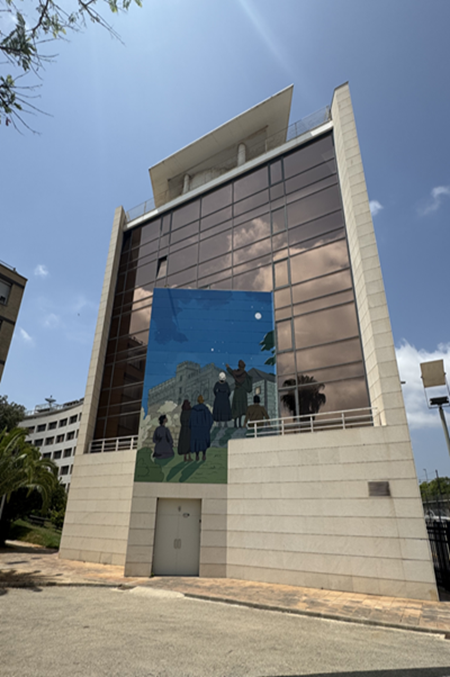
Jerónimo Muñoz (València, 1520 – Valladolid, 1591) was a Valencian mathematician, geographer, engineer, and linguist.
He earned his bachelor's degree in arts from the University of Valencia in 1537 and later continued his studies in various parts of Europe. Among his teachers were the Flemish scholar Gemma Frisius at the University of Leuven and the French mathematician Oronce Finé at the Sorbonne in Paris.
He was a professor of Hebrew at the University of Ancona before taking up a chair at the University of Valencia between 1563 and 1578, where he taught Hebrew and mathematics. In 1579, he moved to the University of Salamanca, drawn by the prestige of this Castilian academic institution and by an improved salary, where he held the chair of mathematics. In 1586, he also began teaching Hebrew. He remained a professor in Salamanca until his death.
Muñoz, along with his students, introduced Copernicus’s theories into the Spanish kingdoms. Although he praised the Polish astronomer’s calculations, in his lectures he would present Copernican heliocentrism only to subsequently refute it using primarily astronomical arguments.
Following the appearance of a new star in the sky over Valencia in 1572 — also observed by the Danish astronomer Tycho Brahe and other European astronomers — King Philip II commissioned him to study the phenomenon. As a result, in 1573 he published in Valencia his book Libro del nuevo cometa y del lugar donde se hacen ("Book of the New Comet and Where They Are Formed"). In this work, when questioning where comets originate, he challenges Aristotle’s notion of the incorruptibility of the heavens, and following the ideas of Anaxagoras and Democritus, argues that comets form in the heavens. This implies that the heavens are of the same nature as the sublunar region of the elements, and therefore are corruptible. This opinion was bold and not well received in court or academic circles. Nevertheless, Muñoz's observations about the comet’s position were accurate, and he determined that its distance was great enough to confirm it was a celestial phenomenon beyond the Moon. Tycho Brahe used Muñoz’s data, praising its precision. His findings were also used by several 17th-century authors, including Galileo, who referenced Muñoz's results in Dialogo sopra i due massimi sistemi del mondo. Today we know that this "new star" was a supernova, now called Tycho’s Supernova or SN 1572.
His works, with the exception of the aforementioned book, were not published and remain scattered in various European libraries. Jerónimo Muñoz did not publish anything further, believing his work was unappreciated and, on the contrary, that he had been insulted by members of the royal court due to his study of the "new comet." Additionally, Muñoz felt it was unwise to publish books on mathematics, stating:
"Spain does not observe the stars, nor does it engage with mathematics, only with mercantile arts. It is reckless — even wasteful — to attempt to publish anything on mathematics, given the enormous printing costs and the lack of buyers for such books..."
In 1991, historian Víctor Navarro presented new findings of Muñoz's manuscript works, some autographed and others as copies. Among them are: commentaries on Pliny’s Natural History; commentaries on the first four books of Euclid’s Elements, based on Theon of Alexandria’s version and Proclus’s commentary on the first book; a short treatise on plane trigonometry; a treatise on the Rojas–Gemma Frisius planisphere and its applications; commentaries on Euclid’s Optics; a treatise on cosmography; and a Latin translation of Theon's commentaries on Ptolemy’s Almagest. These works add to the previously known ones: Libro del nuevo cometa y del lugar donde se hacen; a copy of a letter addressed to Bartholomaeus Reisacher, apparently made by Tycho Brahe; a treatise on astrology kept in the National Library of Madrid; and a short astrological work dedicated to the 1572 comet.
Both Víctor Navarro and V.M. Rosselló have provided evidence supporting the hypothesis that Jerónimo Muñoz played a notable role in the creation of the first printed map of the Kingdom of Valencia, Valentiae regni, olim Contestanorum, by Abraham Ortelius (1586), although the sources remain unknown due to lack of direct documentary evidence.
Jerónimo Muñoz also conducted the first census of the Kingdom of Valencia. By order of the Viceroy Antonio Alfonso Pimentel de Herrera, he compiled between 1565 and 1572 the Descripción de los términos del Reino de Valencia según los números de agora y según este tiempo, en la cual Governación de Orihuela es del reino ("Description of the territories of the Kingdom of Valencia according to current numbers and at this time, in which the Government of Orihuela belongs to the kingdom"), which included data on distances between locations and a population census of all towns, differentiating between Christians and Moriscos.






